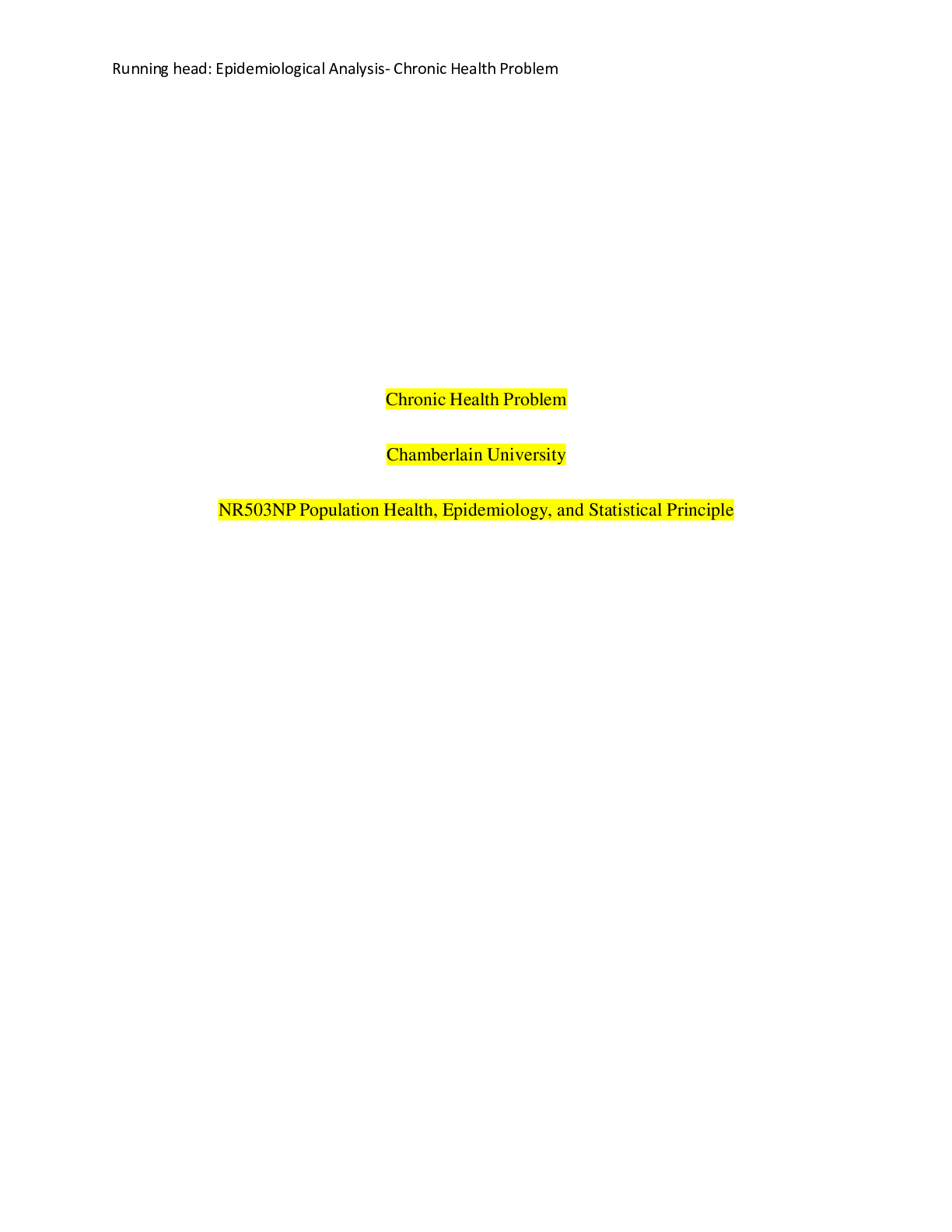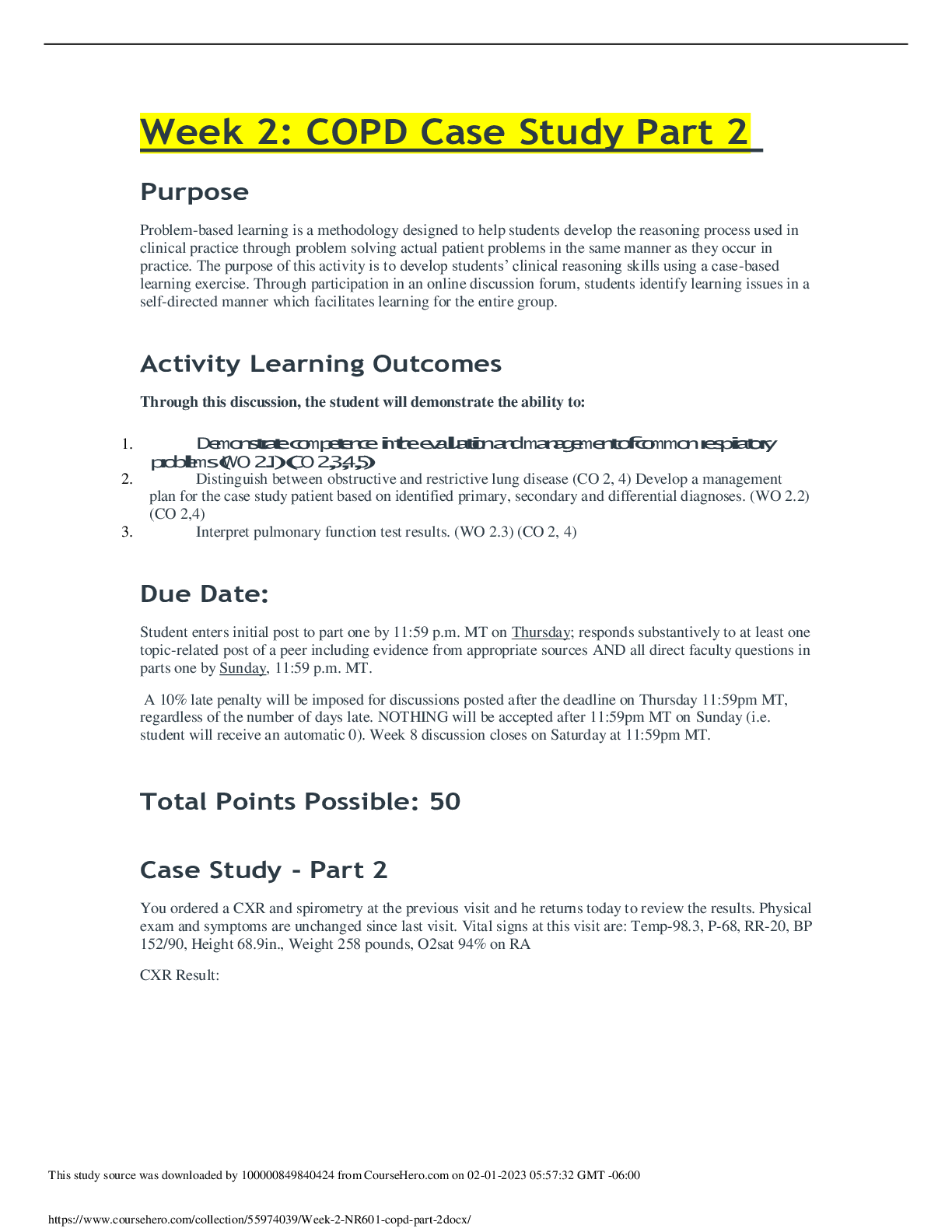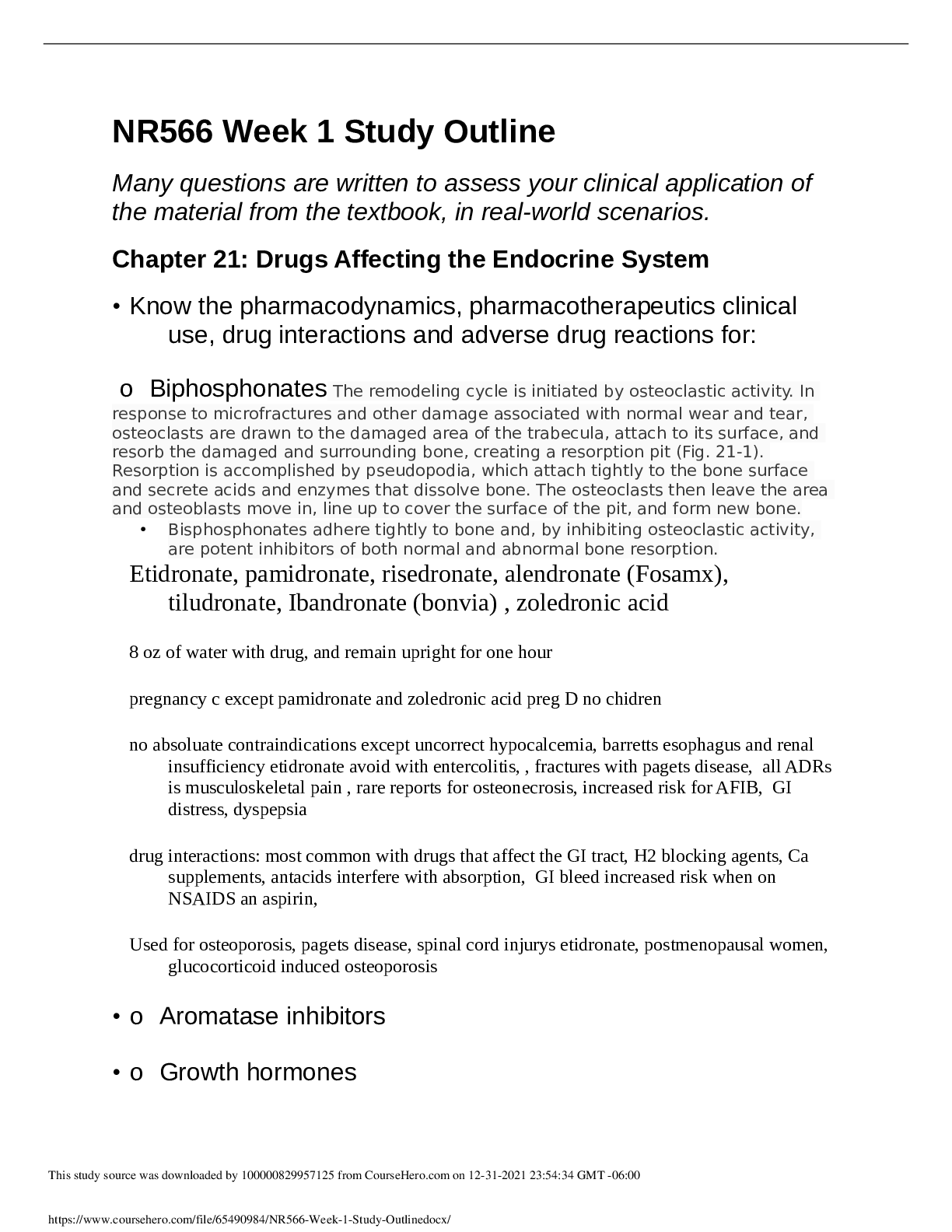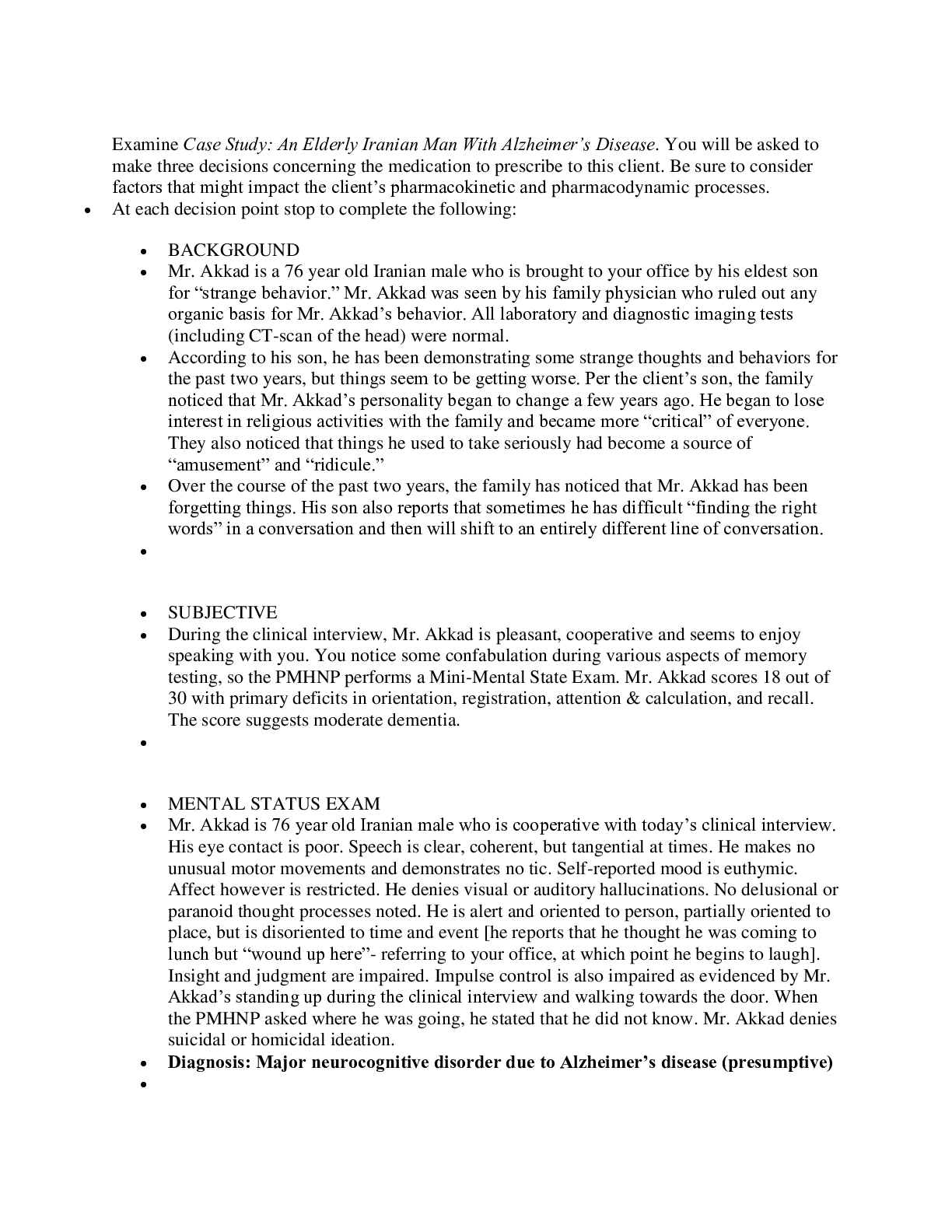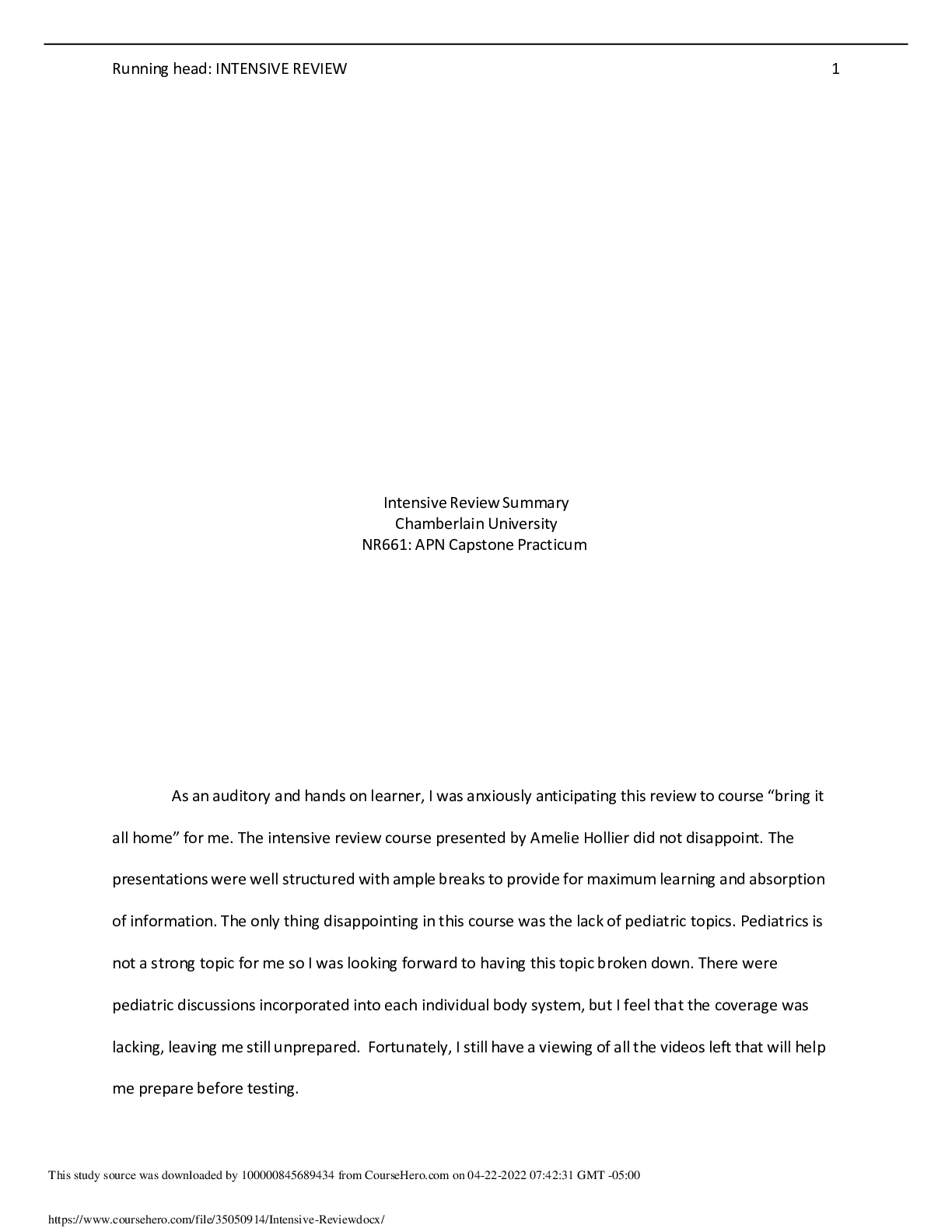*NURSING > CASE STUDY > NURS 6630 Week 7 Assignment: Assessing and Treating Patients With Psychosis and Schizophrenia (GRADE (All)
NURS 6630 Week 7 Assignment: Assessing and Treating Patients With Psychosis and Schizophrenia (GRADED)
Document Content and Description Below
Assessing and Treating Clients With Psychosis and Schizophrenia Walden University NURS -6630, Psychopharmacologic Approaches to Treatment of Psychopathology Introd... uction Psychosis according to National Institute of Mental Health [NIMH] (2016), is used to describe conditions that affect the mind, where the individual has some loss of contact with reality. Psychosis is a symptom, not an illness, and in the U.S., approximately 100,000 young people experience psychosis each year. A person who is in a psychotic episode may experience depression, anxiety, sleep problems, social withdrawal, lack of motivation, and difficulty functioning overall (NIMH, 2016). Psychosis includes a range of symptoms but typically involves one of these two, hallucinations and delusions and treatment may involve psychotherapy and medication. Psychosis also can be related to several mental health conditions such as schizophrenia, bipolar disorder, schizoaffective disorder, and substance abuse (National Alliance on Mental Illness [NAMI], 2019). Schizophrenia is a serious mental illness that affects a person’s ability to think clearly, manage emotions, make decisions and relate to others; hence, it is a complex, long-term medical illness, affecting about 1% of Americans (NAMI, 2019). In the case study for this assignment, a 34-year-old woman from Pakistan presents with a diagnosis of “brief psychotic disorder” following 21 days of hospitalization. After a week of taking the medication Risperdal prescribed to her, she reports to have stopped because of her delusional thinking that her husband is going to poison her. The client has been experiencing delusional and paranoid thoughts such as having visions of Allah, believing she was Prophet Mohammad, and that she would deliver the world from sin (Laureate Education, 2016j). The Positive and Negative Syndrome Scale (PANSS) is administered to the client and her scores reveals a diagnosis of schizophrenia, paranoid type (Laureate Education, 2016j). PANSS is a standardized, clinical interview that rates the presence and severity of positive and negative symptoms, as well as general psychopathology for people with schizophrenia (Depp, Loughran, Vahia, & Molinari, 2010). The purpose of this paper is to show how to assess and treat clients requiring antipsychotic therapy based on the decision concerning the medication to prescribe to a 34-year-old woman from Pakistan with a diagnosis of schizophrenia, influence of pharmacokinetic and pharmacodynamic, and including ethical considerations might impact the treatment plan and communication with clients. Decision One The first decision selected is to start Invega Sustenna 234 mg intramuscular (IM) X1 followed by 156 mg intramuscular on day 4 and monthly thereafter. According to NAMI (2016), paliperidone is a medication that works in the brain in treating schizophrenia and schizoaffective disorder. It is long-acting injectables (LAIs) that allow for the slow release of medicine into the blood, it rebalances dopamine and serotonin to improve thinking, mood, and behavior; therefore it is given monthly. Invega Sustenna works by blocking dopamine 2 receptors, reducing positive symptoms of psychosis and stabilizing affective symptoms; also blocks serotonin 2A receptors, causing enhancement of dopamine release in certain brain regions and thus reducing motor side effects and possibly improving cognitive and affective symptoms (Stahl, 2014b). long-acting antipsychotic injections are a valuable form of therapy; therefore, it may be a suitable option in patients who refuse oral treatment (Bishara, 2010). Zyprexa and Abilify are also antipsychotic (AP) medications used to treat psychosis but will be infective at this time as the client’s symptoms are of delusion and confusion; also the side effects are likely to hinder client from adhering to treatment. LATs were also associated with significantly lower ER visit rates and mental disorder-related and schizophrenia-related rehospitalization rates compared with oral Aps; therefore suggesting that the efficacy and patient tolerability improved patient adherence to the injectable form of the second-generation antipsychotics reducing the demand for hospitalizations and ER visits of relapsed patients with schizophrenia (Lafeuille et al., 2013). The goal for the treatment is for the client to adhere to the treatment and reduction in symptoms within four weeks before returning back to the clinic, also hoping to see a decrease in her PANSS score at the next visit. Psychotic symptoms can improve within 1 week, but it’s recommended to wait at least 4–6 weeks to determine efficacy of drug (Stahl, 2014b). I am expecting that when client returns after four weeks for follow up, she will report tolerating the medication with reduction in psychotic symptoms and improvement in mood. Client returns to clinic in four weeks, reports tolerating medication, and a decrease on her PANSS score of 25% is noted at this visit. Client also reports a 2 pound weight gain but complains of injection site pain stating she has trouble siting for a few hours after the injections. Decision Two My next decision is to continue same decision made but instruct administering nurse to begin injections into the deltoid at this visit and moving forward. Since client showed a 25% decrease in her PANSS score, that’s why I continued same treatment but making changes to injection site due to complaint of not being able to sit after injection. It is important as a practitioner to educate client on side effects of medications before starting and instruct to always consult the provider before stopping any prescribed medication. To discontinue Invega Sustenna and start Haldol Decanoate (haloperidol decanoate ) 50 mg IM q2weeks with oral Haldol 5 mg BID for the next 3 months would not be my recommendation. Studies show that Paliperidone was associated with more weight gain and greater increases in serum prolactin, whereas haloperidol was associated with more akathisia (McEvoy et al., 2014). Haldol an older antipsychotic have been shown to have a higher risk of developing tardive dyskinesia (TD) such as grimacing, sucking, and smacking of lips, or other movements that you cannot control, whereas Paliperidone have lower risk of TD (NAMI, 2016). I will also not recommend to add on Abilify Maintena 300 mg intramuscular monthly with oral Abilify 10 mg in the MORNING for 2 weeks as Abilify IM should not be started until client tolerates oral form (Stahl, 2013). The goal is that the client’s will be without pain and tolerate current injection site to continue treatment and further reduction of her symptoms. I will instruct client to monitor weight as this is a side effect of antipsychotic medications. The expectation with decision two is client will continue with the current treatment plan with a reduction in symptoms with a further decrease in her PANSS score. After four weeks, client returns to clinic with a 50% reduction on her PANSS score, states her pain is much better in the arm. Although client is responding to treatment, she has added a total of 4.5 pounds in two months of which she is bothered by and is afraid that her husband does not like the weight gain. Decision Three At this point, the client has shown significant improvement with the current regimen except being disturbed by the weight gain. My decision at this time is for the client to continue with the Invega Sustenna, counsel client on the fact that weight gain from Invega Sustenna is not as much as what other drugs with similar efficacy can cause, recommend client make an appointment with a dietician and an exercise physiologist, and follow up in one month. According to Stahl (2014b), patients may require up to 16–20 weeks to show a good response and to continue treatment until reaching a plateau of improvement even after reaching a satisfactory plateau, it is best to continue treatment for at least a year after first episode of psychosis. Most antipsychotics cause weight gain and increases rapidly in the initial period after starting antipsychotics with the risk higher with olanzapine and clozapine; therefore, Switching to an agent with lesser tendency to cause weight gain is an option, but carries the risk of relapse of the illness (Dayabandara, 2017). Nonpharmacologic interventions of such as dietary counseling, exercise programs and cognitive and behavioral strategies and intervention strategies have shown effects on weight (Dayabandara, 2017). Abilify does not bind to the D2 receptor and can be less affective also with akathisia as a possible side effect may not be the option for the client (Stahl, 2014b). Qsymia a combination of Phenteramine and Topiramate, is used to treat chronic weight management in adults with an initial BMI of at least 30 kg/m2 (Stahl, 2014b). The expectation is that the client will show even more reduction in symptoms of generalized anxiety disorder. Pharmacodynamics and Pharmocokinetics Paliperidone (Invega) is the major active metabolite of risperidone (Risperdal). In the liver, risperidone is converted to paliperidone. Cells in the brain interact using chemicals known as neurotransmitters. However, too much or too little of these substances in parts of the brain can cause problems; therefore, Paliperidone works by blocking the action of dopamine and serotonin neurotransmitters in certain areas of the brain (Diagnostic and statistical manual of mental disorders [DSM-5], 2013). Due to its extremely low water solubility, the one-month design of paliperidone palmitate dissolves slowly after intramuscular injection before being hydrolyzed to paliperidone and absorbed into the systemic circulation; therefore, after a single intramuscular dose, the plasma concentrations of paliperidone gradually rise to reach maximum plasma concentrations at a median Tmax of 13 days; hence, the release of the drug starts as early as day one and lasts for as long as 126 days. A 28% higher Cmax was observed in the deltoid muscle compared with injection in the gluteal muscle following single doses of intramuscular injection (39 mg – 234 mg; DailyMed, 2018). Conclusion with Ethical Considerations In mental health care, ethics and culture are intertwined. It is important as a practitioner to be cognizant of different background and beliefs being aware, sensitive, and showing empathy for a client as an individual, including his or her cultural values and beliefs (Hoop, DiPasquale, Hernandez, & Roberts, 2008). It is important to involve the client and family with the client’s consent in educating on treatment and treatment plan for a better outcome, discussing the risk and benefits, side effects, and any changes during treatment plan. The client in this case is a Pakistani woman where culture plays a part as to mental illness may be hidden to prevent being talked about in her society. Patients with psychosis and schizophrenia may require help in decision making and also require special attention, because these conditions have effects on the patient’s brain. In conclusion, as a practitioner is it always beneficial to involve the client in decision making as this gives the client a sense of empowerment, making sure they give their clients the best possible treatment and they are surrounded by people who will help them recover. It is also very crucial to always respect the client’s privacy and confidentiality. References Bishara, D. (2010). Once-monthly paliperidone injection for the treatment of schizophrenia. Neuropsychiatric disease and treatment, 6(561-72). doi:10.2147/NDT.S8505. DailyMed. (2018). INVEGA SUSTENNA- paliperidone palmitate injection. Retrieved from https://dailymed.nlm.nih.gov/dailymed/drugInfo.cfm?setid=1af14e42-951d-414d-8564- 5d5fce138554#pubmed-menu Dayabandara, M., Hanwella, R., Ratnatunga, S., Seneviratne, S., Suraweera, C., & de Silva, V. A. (2017). Antipsychotic-associated weight gain: management strategies and impact on treatment adherence. Neuropsychiatric disease and treatment, 13, 2231-2241. doi:10.2147/NDT.S113099. Depp, C. A., Loughran, C., Vahia, I., & Molinari, V. (2010). Assessing Psychosis in Acute and Chronic Mentally Ill Older Adults. Handbook of Assessment in Clinical Gerontology (2nd ed., pp.123-154). https://doi.org/10.1016/B978-0-12-374961-1.10005-3 Diagnostic and statistical manual of mental disorders. [electronic resource] : DSM-5. (2013). Washington, D.C. : American Psychiatric Association, c2013. Retrieved from https://ezp.waldenulibrary.org/login?url=https://search.ebscohost.com/login.aspx? direct=true&db=cat06423a&AN=wal.DSM5&site=eds-live&scope=site Hoop, J. G., DiPasquale, T., Hernandez, J. M., & Roberts, L, W. (2008) Ethics and Culture in Mental Health Care. ETHICS & BEHAVIOR, 18(4) 353-372, DOI: 10.1080/10508420701713048 Lafeuille, M. H., Laliberté-Auger, F., Lefebvre, P., Frois, C., Fastenau, J., & Duh, M. S. (2013). Impact of atypical long-acting injectable versus oral antipsychotics on rehospitalization rates and emergency room visits among relapsed schizophrenia patients: a retrospective database analysis. BMC psychiatry, 13(221). doi:10.1186/1471-244X-13-221 Laureate Education. (2016j). Case study: Pakistani woman with delusional thought processes [Interactive media file]. Baltimore, MD: Author McEvoy, J. P., Byerly, M., Hamer, R. M., Dominik, R., Swartz, M. S., Rosenheck, R. A., … Stroup, T. S. (2014). Effectiveness of paliperidone palmitate vs haloperidol decanoate for maintenance treatment of schizophrenia: a randomized clinical trial. JAMA, 311(19), 1978-87. doi:10.1001/jama.2014.4310 National Alliance on Mental Illness. (2016). Paliperidone (Invega). Retrieved from https://www.nami.org/Learn-More/Treatment/Mental-Health-Medications/paliperidone- (Invega) National Alliance on Mental Illness. (2019). Early Psychosis And Psychosis. Retrieved from https://www.nami.org/earlypsychosis National Alliance on Mental Illness. (2019). Schizophrenia. Retrieved from https://www.nami.org/Learn-More/Mental-Health-Conditions/Schizophrenia National Institute of Mental Health. (2016). What is Psychosis? Retrieved from https://www.nimh.nih.gov/health/topics/schizophrenia/raise/what-is-psychosis.shtml Stahl, S. M. (2013). Stahl’s essential psychopharmacology: Neuroscientific basis and practical applications (4th ed.). New York, NY: Cambridge University Press. Stahl, S. M. (2014b). The prescriber’s guide (5th ed.). New York, NY: Cambridge University Press. [Show More]
Last updated: 2 years ago
Preview 1 out of 9 pages

Buy this document to get the full access instantly
Instant Download Access after purchase
Buy NowInstant download
We Accept:

Reviews( 0 )
$11.00
Can't find what you want? Try our AI powered Search
Document information
Connected school, study & course
About the document
Uploaded On
Jul 25, 2022
Number of pages
9
Written in
Additional information
This document has been written for:
Uploaded
Jul 25, 2022
Downloads
0
Views
94
.png)



